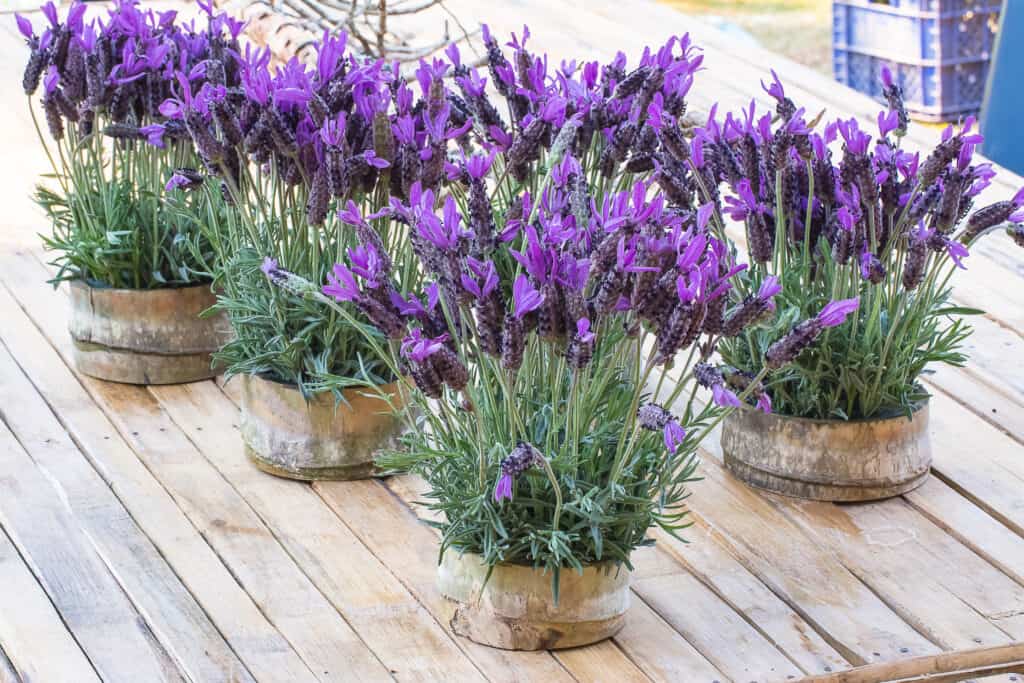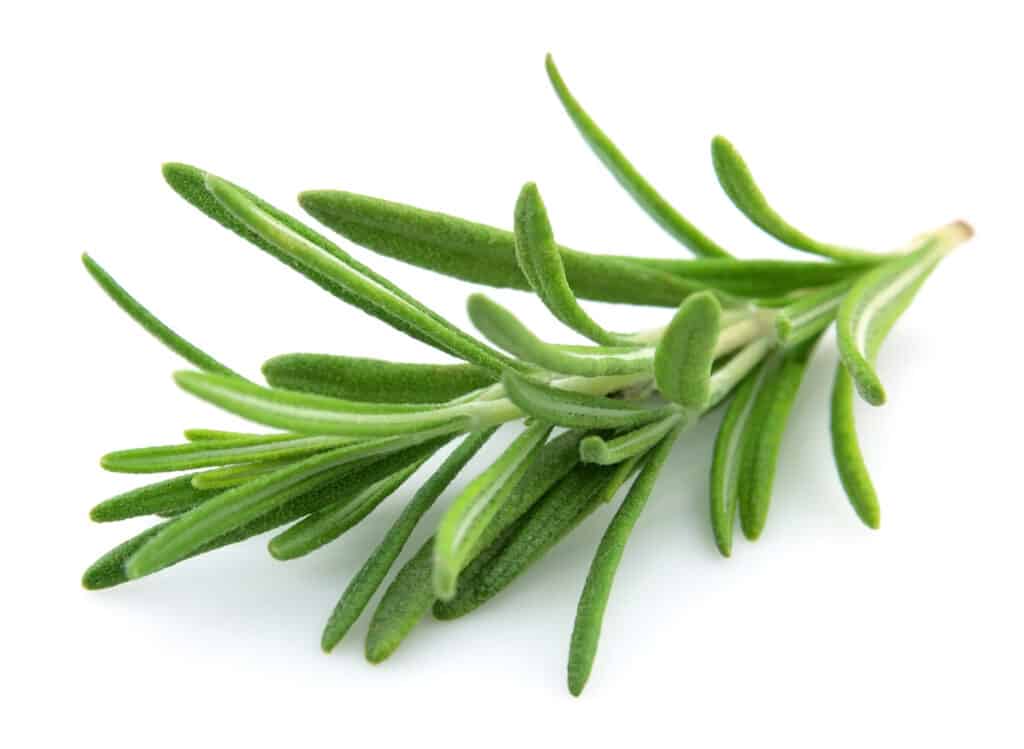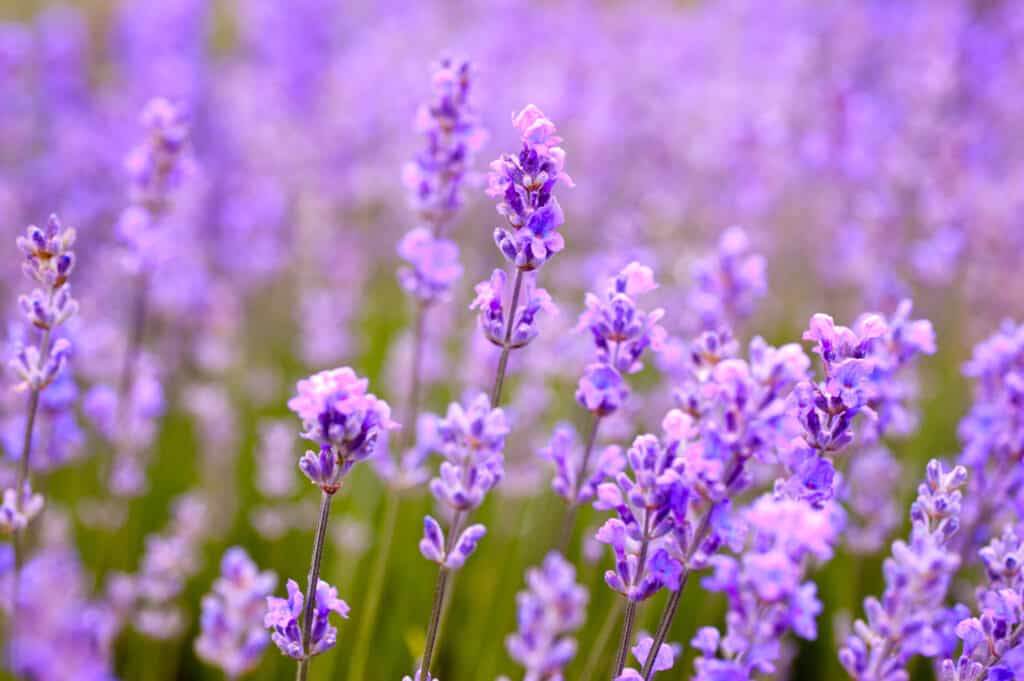Rosemary and lavender are both known for their lovely aromas and culinary uses. While those who’ve only interacted with the plants in grocery stores and U-pick fields may not see the resemblance, they’re commonly confused in the wild. So, rosemary vs. lavender: find out the differences between these useful, delicious plants in this article and how you can grow your own.

Comparing Rosemary vs. Lavender
| Rosemary | Lavender | |
|---|---|---|
| Classification | Salvia rosmarinus | Lavandula spica |
| Alternative Names | Dew of the Sea, Sea Dew | N/A |
| Origin | The Mediterranean – Ancient Greece and Rome | Africa, Asia, Europe |
| Description | Named for its color, lavender grows in vertical stalks. Petals can also bloom in shades of pink, dark purple, yellow, and white. It grows 2-3 feet tall and is recognizable by its floral, herbal scent. | Used most often in aromatherapy for calm and relaxation—also a culinary ingredient in baked goods and cocktails. |
| Uses | Most often used in savory culinary dishes. Used in ancient times as herbal medicine to create muscle rubs and tea. | Used most often in aromatherapy for calm and relaxation. Also a culinary ingredient in baked goods and cocktails. |
| Growth Tips | Germinate seeds 12 weeks before the last frost in a warm, humid environment or propagate cuttings from an established plant. Transplant to a garden pot to overwinter indoors or plant outside in USDA Zones 6-9 in full sun. Soil should be well-draining. | Germinate seeds four weeks before the last frost in a warm, humid environment or propagate cuttings from an established plant. Transplant to a pot or garden in USDA Zones 5-9 in full sun. Soil should be well-draining. |
Rosemary vs. Lavender: Key Differences
For people in North America, rosemary and lavender are easy to differentiate. However, the differences aren’t as apparent in the Mediterranean and Asia, where it grows in the wild.
Rosemary has deep green needles, similar to a pine tree. The stalks are woodier, and the scent is more herbaceous and savory than lavender. Lavender has soft, silvery green leaves and a sweeter, more perfumey scent.
Rosemary typically grows larger than lavender, both vertically and horizontally. Lavender blooms also grow on individual spikes, elevated from the stalks, while rosemary blooms directly from the stem.
Rosemary vs. Lavender: Classification
Rosemary and lavender are both in the family Lamiaceae, which contains primarily flowering plants, many of which have shrub-like qualities. These plants are considered closely related to the Verbenaceae family of flowering plants, which often feature flower “spikes” like those found on lavender. That’s where the genetic similarities end.
Rosemary is in the genus Salvia, which it shares with sage. The word Salvia is derived from the word salvus, a Latin term meaning “health” and “safety.” This origin likely refers to rosemary and sage’s prevalence in ancient remedies.
Lavender is in the genus Lavandula, which refers to flowering plants within the mint family — most of which are lavender hybrids and cultivars.

Lavender is in the genus
Lavandula, which refers to flowering plants within the mint family.
©Shan 16899/Shutterstock.com
Rosemary vs. Lavender: Origin
Rosemary and lavender share a common history. Both plants were used frequently in Ancient Greece and Rome. The Romans believed that rosemary could improve one’s memory, making it a common aromatic accessory while studying.
Lavender was often added to baths in ancient times for its lovely scent and to ward away illness. It was popular during plague times for its apparent protective properties. Historians believe this was correlation rather than causation — fleas, a leading plague transmitter, hate the smell of lavender!
Both rosemary and lavender grow naturally in parts of Europe and Asia, particularly around the Mediterranean. Lavender extends further south into Africa as well.
Rosemary vs. Lavender: Description
From a distance, rosemary and lavender look similar in the wild. While both plants are types of shrubs, rosemary has a more “shrub-like” appearance. It has woody needles rather than soft leaves and can grow up to six feet high in ideal conditions. The scent of rosemary is often confused with that of lavender in the wild, though it’s more herbaceous and savory.
Lavender also grows in vertical stalks, with blooms on flower spikes extending away from the foliage. This wild semi-shrub grows approximately three feet tall in ideal conditions and often appears taller when in full bloom. Lavender leaves are soft and have a silvery-green tone.
Both rosemary and lavender have similar flowers in shades of white, purple, pink, and blue. Some lavender cultivars also bloom in yellow.

If you check rosemary closely, you will note that it has woody needles rather than soft leaves.
©iStock.com/Volosina
Rosemary vs. Lavender: Uses
Both Rosemary and lavender are used frequently in aromatherapy and cooking.
Rosemary is an excellent addition to savory dishes and drinks. There’s a gap in the historical records about how rosemary became naturalized worldwide, but it started showing up in English culinary texts during the middle ages. It was also used to make perfume and as a Christmas decoration with holly and mistletoe.
Lavender is still used in aromatherapy to induce a sense of calm and relaxation. It’s also dried and displayed as decor or added to ornamental gardens.
Both rosemary and lavender deter pests like mosquitos and fleas, making them the perfect addition to an outdoor sitting area or lotion during the summer months.
Rosemary vs. Lavender: Growth Tips
Both rosemary and lavender are difficult to grow from seed. Gardening experts recommend taking a cutting from a well-established plant instead. These seeds often differ from their parent plant, and many fail to germinate. If you choose to start from seed, allow plenty of time before the last frost and germinate more seeds than you think you’ll need.
To grow rosemary from seed, start the seeds at least 12 weeks before the last frost. Sprout the seeds in a warm, humid environment, like a covered transplant tray or a moist paper towel in a plastic bag. Transplant the seedlings to a garden pot if you live outside USDA Zones 6-9 so you can bring this perennial indoors for the winter. Rosemary requires full sun and well-draining soil and won’t tolerate shade or overwatering.
To grow lavender from seed, start the germination process four weeks before the last frost in a warm, humid environment. Transplant the seedlings into well-draining soil in a pot or garden in USDA Zones 5-9 in full sun. There’s a common misconception that lavender is an annual. It will come back in the spring if cared for and overwintered indoors.

Most lavenders are hardy from Zones 5 to 9.
©reya-photographer/Shutterstock.com
The photo featured at the top of this post is © iStock.com/Artfully79
Sources
- Online Etymology Dictionary, Available here: https://www.etymonline.com/word/sage?ref=etymonline_crossreference#etymonline_v_22602
- Atlas Obscura, Available here: https://www.atlasobscura.com/articles/plague-doctor-clothes
- , Available here: https://www.cs.mcgill.ca/~rwest/wikispeedia/wpcd/wp/l/Lavender.htm
Thank you for reading! Have some feedback for us? Contact the AZ Animals editorial team.






